My wife, Anne, came home from router class (Cisco rather than the
woodworking) and said a classmate had some old Macs that his wife
wanted out of the house. He'd said he hated to just throw them away and
asked Anne if I might be interested in them. As things go with night
classes and professionals, Anne and her classmate didn't make
connections for several weeks as each in turn had other obligations. I
honestly felt like a kid waiting for Christmas.
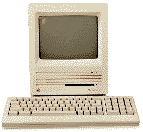 Would there be a Color Classic or an
SE/30 in the bunch? Maybe
there'd be an old LC or even a
Power Mac 6100. The
prospect was truly exciting. You see, while I currently own five
working Macs, all are committed in some way or other here at home or at
school, and they all need to be available for service. The other
machines about which I frequently write are owned by others, most often
the school system for which I teach. A windfall of uncommitted Macs
would give me some spares, some machines with which to fiddle with no
pressure, and possibly a machine to donate somewhere it might do some
good.
Would there be a Color Classic or an
SE/30 in the bunch? Maybe
there'd be an old LC or even a
Power Mac 6100. The
prospect was truly exciting. You see, while I currently own five
working Macs, all are committed in some way or other here at home or at
school, and they all need to be available for service. The other
machines about which I frequently write are owned by others, most often
the school system for which I teach. A windfall of uncommitted Macs
would give me some spares, some machines with which to fiddle with no
pressure, and possibly a machine to donate somewhere it might do some
good.
Another part of me worried that I'd receive boxes with nothing more
than a few spare parts amongst the worn out components. But Macs have
an incredibly long life span, so I had good reason to hope the boxes
might be usable by themselves or in combination with a few replacement
parts.
The big day finally came. Annie came home from class carrying a
laundry basket full of mice, keyboards, assorted cables and cords, and
even a few external drives. As she came in, she said, to my relief,
"This isn't all of it. There's more in the trunk." And so there
was.
Nestled in the trunk of our last Ford (ah, but that's another story)
were a Mac II, a Mac IIcx, and an Apple Color High
Resolution RGB display. As we carried them in, Anne related that the
erstwhile owner had said that he thought one of the computers
worked.
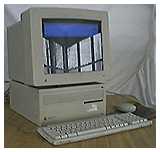 I first tried the Mac
IIcx with the 12" display. It fired up immediately. It's 250 MB hard
drive contained FileMaker Pro 2.0, Microsoft Works 2.0, Multi-Ad
Creator 2.5, and WordPerfect 3.0, all running well under System 7.0.1.
I was also pleasantly surprised to find it had 8 MB of RAM and a floppy
drive in good working condition (often either missing or malfunctioning
in the older Macs that pass my way).
I first tried the Mac
IIcx with the 12" display. It fired up immediately. It's 250 MB hard
drive contained FileMaker Pro 2.0, Microsoft Works 2.0, Multi-Ad
Creator 2.5, and WordPerfect 3.0, all running well under System 7.0.1.
I was also pleasantly surprised to find it had 8 MB of RAM and a floppy
drive in good working condition (often either missing or malfunctioning
in the older Macs that pass my way).
Having found the computer "that works," I tried the Mac II and found
the monitor remained down on startup. I could hear the drive loading,
however. I swapped out the video cards to no avail and then realized
the display just wasn't getting any power. I switched monitor power
cables to one that runs to an outlet rather than running off the
computer's power supply. When I restarted, I was greeted with good old,
dependable System 6.
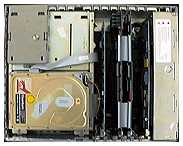 The Mac
II's full-size 40 MB drive was failing, so I first saved the contents
to a Zip disk. In the process, I found the Mac II was also having some
SCSI problems. This obviously was the machine that "didn't work. From
the contents of its hard drive, I could tell it had done some serious
computing at one time. There were lots of documents and applications
including MacDraw II, Cricket Graph, Smartcom II, StuffIt 1.5.1,
HyperCard 1.0.1, MacProject 1.0, MacLinkPlus 7.0, Microsoft Word 4.0,
Excel 4.0, and PowerPoint 2.0, MacPaint 2.0, SuperPaint 2.0, and Norton
Utilities 2.0.
The Mac
II's full-size 40 MB drive was failing, so I first saved the contents
to a Zip disk. In the process, I found the Mac II was also having some
SCSI problems. This obviously was the machine that "didn't work. From
the contents of its hard drive, I could tell it had done some serious
computing at one time. There were lots of documents and applications
including MacDraw II, Cricket Graph, Smartcom II, StuffIt 1.5.1,
HyperCard 1.0.1, MacProject 1.0, MacLinkPlus 7.0, Microsoft Word 4.0,
Excel 4.0, and PowerPoint 2.0, MacPaint 2.0, SuperPaint 2.0, and Norton
Utilities 2.0.
The machine also had some 12" NuBus cards I didn't recognize,
including two that were tied together with a couple of SCSI tapes! Upon
removal, I saw stamped on one of the cards, AST Mac 286! Apparently,
it's a DOS card of some sort. [It was the first DOS card for the Mac
II. dk] I did a few web searches but didn't find any good matches, so I
put out a posting to the good folks at the Vintage Mac mailing list. Collectively,
they know everything there is to know about older Macs. And if by
chance they don't, the Classic Mac mailing folks do.
I was obviously in Low End Mac heaven with all of this ancient
hardware and software. I had to play with the apps a bit on each
machine, but gave up on the Mac II as it repeatedly required bopping
the hard drive to keep it from displaying the "does not recognize this
drive" message and its invitation to initialize or eject the drive.
Of the two machines, the IIcx had more immediate possibilities for
use, as it uses standard 30-pin SIMMs. I already had a destination in
mind for the unit and set to work upgrading it. I still had four 4 MB
chips left over from my oft put off SE/30 Internet project. The added
RAM brought it to a respectable 20 MB which worked well once I
installed
System 7.5.3 and
Mode 32.
This was my first foray inside an unfamiliar Mac since Apple posted
its off-and-on
service manuals download directory. (When I checked links on March
12, the directory appeared empty, although the IIcx link worked!) The
IIcx manual (660K PDF document) did note that a latch needed to be
pushed to release the power supply. Finding the latch under the power
supply and figuring out which way to push it took a few minutes, but I
found it reassuring to have the manual on the hard drive of my G3 for
reference.
The power supply really doesn't need to be removed to swap hard
drives, but I wanted to put a new battery in the IIcx and you have to
pull the power supply and the drive brackets to get to the battery.
Tearing the machine down to the motherboard also facilitated a thorough
cleaning. In any case, I just wanted to see how it came apart, so
everything came out!
At this point, I must admit that I brought home an unused Mac IIcx
from school that has been serving as a parts donor. I used it for most
of the interior photography or when I thought I might stress something,
I first tried it on the school's cx before trying it on "my" cx. In the
end, I couldn't resist trying to get them both up and running. I did,
but the school's machine still lacks a floppy drive.
I found that I had enough extra software to equip the IIcx without
any new purchases. I used up one of my extra ClarisWorks licenses and
added a few of my regular freeware add-ons, such as Forward
Delete (8K) and PopChar Lite
(82K). I even installed ColorIt! and Now WYSIWYG from
an old set of Macworld Mac
Secrets' disks. The most important piece of software I added last:
GradeBook Plus, as this Mac IIcx was destined for the home of my instructional
assistant. While they have a functioning PC in their home, she has
often said she wished she could do grades at home on a Mac. While I
couldn't give her one of the school's Macs and the rest of mine were
committed, this windfall of Macs provided the perfect opportunity.
I've raved previously about my excellent assistant. One of her more
recent computing advances has been the adaptation of some of my math
sharewares for some of our younger set in the learning disabilities
classroom. She regularly manipulates the cluster boxes from MATH DITTOS 02. Fact
Controlled Addition & Subtraction for Special Learners, adds
new problems, and generally relieves me of one very
active but important math group! I obligingly added a copy of
her MATH DITTOS 2 files from her Mac at
school. Along with a bunch of freeware games (My assistant has two
kids who truly appreciate the Macintosh platform.), I suspect this
older Mac will receive a good bit of use.
Odd Thoughts While Shaving Between Paragraphs:
 Just a week ago,
those of us in central Indiana were enjoying record temperatures in the
70's. As I tore down the old Macs for this week's column in our sun
room, my view was substantially changed from last week.
Just a week ago,
those of us in central Indiana were enjoying record temperatures in the
70's. As I tore down the old Macs for this week's column in our sun
room, my view was substantially changed from last week.
Some readers may have been expecting a review of AppleWorks 6 from me this week.
I did receive my copy and have given it a bit of a workout. My first
impressions of the release are mixed. I'm not going to comment much on
the layout or floating pallets until I've used them a bit. The release
obviously looks a lot different.
I have noticed that the new release is a bit sluggish on my G3/266. I've also had at least
one crash at the end of an hour long AppleWorks 6 session.
I'm hopeful that this release will prove workable or that there will
be updates and/or patches to correct some of the deficiencies noted
elsewhere on the web. Like many educators, I've come to rely on
ClarisWorks/AppleWorks as my main word processor.
Low End Mac is an independent publication and has not been authorized,
sponsored, or otherwise approved by Apple Inc. Opinions expressed are
those of their authors and may not reflect the opinion of Cobweb
Publishing. Advice is presented in good faith, but what works for one
may not work for all.
unless otherwise noted. All
rights reserved. Low End Mac, LowEndMac, and lowendmac.com are
trademarks of Cobweb Publishing Inc. Apple, the Apple logo, Macintosh,
iPad, iPhone, iMac, iPod, MacBook, Mac Pro, and AirPort are
Additional company and product names may be trademarks or
registered trademarks and are hereby acknowledged.
: We allow and encourage links to
any public page as long as the linked page does not appear within a
frame that prevents bookmarking it.
Email may be published at our discretion unless marked "not for
publication"; email addresses will not be published without permission,
and we will encrypt them in hopes of avoiding spammers. Letters may be
edited for length, context, and to match house style.
: We don't collect personal
information unless you explicitly provide it, and we don't share the
information we have with others. For more details, see our

 Would there be a
Would there be a  I first tried the Mac
IIcx with the 12" display. It fired up immediately. It's 250 MB hard
drive contained FileMaker Pro 2.0, Microsoft Works 2.0, Multi-Ad
Creator 2.5, and WordPerfect 3.0, all running well under System 7.0.1.
I was also pleasantly surprised to find it had 8 MB of RAM and a floppy
drive in good working condition (often either missing or malfunctioning
in the older Macs that pass my way).
I first tried the Mac
IIcx with the 12" display. It fired up immediately. It's 250 MB hard
drive contained FileMaker Pro 2.0, Microsoft Works 2.0, Multi-Ad
Creator 2.5, and WordPerfect 3.0, all running well under System 7.0.1.
I was also pleasantly surprised to find it had 8 MB of RAM and a floppy
drive in good working condition (often either missing or malfunctioning
in the older Macs that pass my way). The Mac
II's full-size 40 MB drive was failing, so I first saved the contents
to a Zip disk. In the process, I found the Mac II was also having some
SCSI problems. This obviously was the machine that "didn't work. From
the contents of its hard drive, I could tell it had done some serious
computing at one time. There were lots of documents and applications
including MacDraw II, Cricket Graph, Smartcom II, StuffIt 1.5.1,
HyperCard 1.0.1, MacProject 1.0, MacLinkPlus 7.0,
The Mac
II's full-size 40 MB drive was failing, so I first saved the contents
to a Zip disk. In the process, I found the Mac II was also having some
SCSI problems. This obviously was the machine that "didn't work. From
the contents of its hard drive, I could tell it had done some serious
computing at one time. There were lots of documents and applications
including MacDraw II, Cricket Graph, Smartcom II, StuffIt 1.5.1,
HyperCard 1.0.1, MacProject 1.0, MacLinkPlus 7.0, 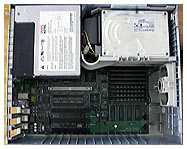
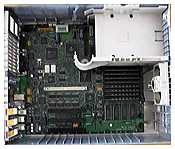
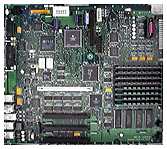
 Just a week ago,
those of us in central Indiana were enjoying record temperatures in the
70's. As I tore down the old Macs for this week's column in our sun
room, my view was substantially changed from last week.
Just a week ago,
those of us in central Indiana were enjoying record temperatures in the
70's. As I tore down the old Macs for this week's column in our sun
room, my view was substantially changed from last week.
